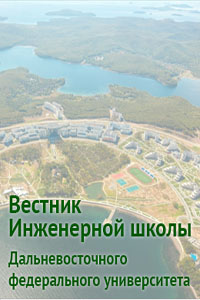Technical factors for ensuring the stability of the foam concrete mix
DOI:
https://doi.org/10.24866/2227-6858/2025-3/118-127Keywords:
foam concrete, foam stabilization, three-phase systems, hydrostatic equilibrium, sedimentation, coalescenceAbstract
This article examines the stability of three-phase foams and the relationship between the mechanisms of destruction and the features of the foam structure. In this case, the necessary technological task will be to ensure hydrostatic equilibrium in the Plateau – Gibbs channels in the foam concrete mixture. In the technology of lightweight foam concrete, many methods of structure stabilization have been proposed – the introduction of reinforcing elements, pre-hydration of cement, the use of micro-fillers and reduction of the dispersion of the solid phase. To ensure the necessary stability of the mixture, a set of control actions and an optimal combination of input parameters are required, on which the sedimentation stability of the technophase colloidal foam mortar system and the quality of the final product depend.
References
1. Ta X., Zhang Y., Wan Z., Li, J. Study on preparation method and carbon fixation performance of supercritical CO2-foamed concrete // Construction and Building Materials. 2025. Vol. 491. P. 142759. https://doi.org/10.1016/j.conbuildmat.2025.142759.
2. Баженов Ю.М., Федюк Р.С., Лесовик В.С. Обзор современных высокоэффективных бетонов // Наукоёмкие технологии и инновации: Электронный сборник докладов Международной научно-практической конференции, посвящённой 65-летию БГТУ им. В.Г. Шухова. 2019. С. 45–49.
3. Zhang G., He Y., Yang J., Ding Q., D. Sun, Wang X. Performance optimization of low-carbon phosphogypsum foam concrete: Influence mechanisms of different activators // Journal of Building Engineering. 2025. Vol. 112. Р. 113688. https://doi.org/10.1016/j.jobe.2025.113688.
4. Моргун Л.В. Пенобетон. Монография. Ростов-на-Дону: изд-во РГСУ, 2012. 154 с.
5. Меркин А.П. Научные и практические основы улучшения структуры и свойств поризованных бетонов: дисс. ... д-ра техн. наук. М., 1973. 290 с.
6. Shi M., Yin G., Hao W., Zhang W., Zhang J., Wei P., Feng J., Qiang L., Zhang W., Zhu D. Mechanical and energy absorption characteristics of foamed concrete under different quasi-static compression tests // Results in Engineering. 2025. Vol. 27. Р. 105887. https://doi.org/10.1016/j.rineng.2025.105887.
7. Zhang Y., Wu D., Qin S., Shi P., Deng R. Preparation of sulfoaluminate cementitious carbon dioxide foamed concrete: Application to coal mine insulation // Construction and Building Materials. 2025. Vol. 490. Р. 142449. https://doi.org/10.1016/j.conbuildmat.2025.142449.
8. Sun Y., Wang H., Zhang Y., Liu X., Ma G. Spray-based 3D printed foam concrete: Stress concentration relieve utilization // Construction and Building Materials. 2025. Vol. 485. Р. 141871. https://doi.org/10.1016/j.conbuildmat.2025.141871.
9. Nandakrishna R., Sathyan D., Athira R. Enhancing thermal comfort and durability of foam concrete infill blocks through surface modifications // Results in Engineering. 2025. Vol. 27. Р. 106096. https://doi.org/10.1016/j.rineng.2025.106096.
10. Compaore A., N’Zy Kicoun Toure J.-Y., Primus Klenam D.E., Merenga A.S., Asumadu T.K., Obayemi J.D., Rahbar N., Migwi C., Soboyejo W.O. Foam concrete with mineral additives: from microstructure to mechanical/physical properties, workability and durability // Open Ceramics. 2025. Vol. 23. Р. 100812. https://doi.org/10.1016/j.oceram.2025.100812.
11. Compaore A., N’Zy Kicoun Toure J.-Y., Primus Klenam D.E., Asumadu T.K., Obayemi J.D., Rahbar N., Migwi C., Merenga A.S., Soboyejo W.O. Performance of foam concrete containing relatively low temperature calcined clay as partial replacement of portland cement // Journal of Materials Research and Technology. 2025. https://doi.org/10.1016/j.jmrt.2025.07.137.
12. Jia H., Feng X., Cui B., Liu Z. Design and thermal insulation simulation of nano-SiO2 foam concrete and vacuum insulation panel system for building exterior wall insulation // Energy. 2025. Vol. 330. P. 136833. https://doi.org/10.1016/j.energy.2025.136833.
13. Алексейко Л.Н., Таскин А.В. О комплексной переработке золошлаковых отходов энергетики // Экология и развитие общества. Труды IX Международной конференции. Международная академия наук экологии, безопасности человека и природы (МАНЭБ). 2005. С. 12–21.
14. Алексейко Л.Н., Таскин А.В., Черепанов А.А. Технологическая линия для переработки золошлаковых отходов – продуктов сжигания угольного топлива // Патент на изобретение RU 2489214 C1, 10.08.2013. Заявка № 2012123064/03 от 04.06.2012.
15. Панков П.П., Коновалова Н.А., Размахнин К.К., Бесполитов Д.В. Структурообразование композиционных материалов, модифицированных добавками природного цеолита и высокомолекулярных веществ // Известия высших учебных заведений. Строительство. 2024. № 9 (789). С. 54–64.
16. Панков П.П., Коновалова Н.А., Размахнин К.К., Бесполитов Д.В. Органо-неорганические композиционные материалы на основе отходов горнорудных предприятий // Известия высших учебных заведений. Строительство. 2025. № 2. С. 64–75.
17. Levkina E.V., Titova N.Y. The analysis of the financial condition of small business and the ways of its development in the Primorsky Territory // IOP Conference Series: Earth and Environmental Science, 2019, № 272 (3), art. 032185. DOI: https://doi.org/10.1088/1755-1315/272/3/032185.
18. Левкина Е.В., Лялина Ж.И., Локша А.В., Савостина С.Е. Финансовые аспекты обеспечения экономической безопасности: многоуровневый подход. Владивосток, 2022. 169 с.
19. Левкина Е.В., Лялина Ж.И., Курасова Е.А. Актуальность исследования экономической безопасности как экономической категории // Экономическая безопасность. 2022. Т. 5. № 1. С. 339–350.
20. Касумов Аяз Шахин Оглы. Пенобетон с повышенными эксплуатационными свойствами: Автореферат дисс. … канд. техн. наук. М., 2017. 25 с.
21. Костыленко К.И. Закономерности обеспечения структурной устойчивости пенобетонных смесей: Автореферат дисс. … канд. техн. наук 05.23.05. Ростов-на-Дону, 2014.
22. Aveyard R. Liquid droplets and solid particles at surfactant solution interfaces // Chem. Soc. Faraday Trans. 1995. Vol. 91, № 17. P. 2681–2697.
23. Kruglyakov P.M. Hydrophile-lipophile balance of surfactants and solid particles. Physicochemical aspects and applications. Amsterdam: Elsevier, 2000. 391 p.
24. Шевнина Т.Е. Фрактально-перколяционный механизм разрушения пены: Автореферат дисс. … канд. физ.-мат. наук: 02.00.04. Тюмень, 2004. 26 с.
25. Гленсдорф П., Пригожин И.Р. Термодинамическая теория структуры, устойчивости и флуктуаций. М.: Мир, 1973. 280 с.
26. Вилкова Н.Г. Свойства пен и методы их исследования. Пенза, ПГУАС, 2013. 120 с.
Downloads
Published
Issue
Section
License
Copyright (c) 2025 Far Eastern Federal University: School of Engineering Bulletin

This work is licensed under a Creative Commons Attribution 4.0 International License.

